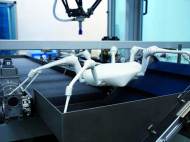A new lightweight robot inspired by spiders
 Spiders have inspired a group of researchers from the Fraunhofer Institute for Manufacturing Engineering and Automation IPA to create a mobile robot which looks and moves as spiders. This high-tech assistant is still a prototype, but researchers envision its use as an exploratory tool in environments that are too hazardous or hardly reachable for humans.
Spiders have inspired a group of researchers from the Fraunhofer Institute for Manufacturing Engineering and Automation IPA to create a mobile robot which looks and moves as spiders. This high-tech assistant is still a prototype, but researchers envision its use as an exploratory tool in environments that are too hazardous or hardly reachable for humans.
“We took this mobility principle and applied it to our bionic, computer-controlled lightweight robot. Its eight legs and body are also fitted with elastic drive bellows that operate pneumatically to bend and extend its artificial limbs“, said Dipl.-Ing. Ralf Becker, a scientist at Fraunhofer IPA.
The components required for robot’s movement, such as the control unit, valves and compressor pump, are located in its body. The robot can carry various sensors and measuring devices which are required for the needed application. Hinges interoperate with the bellows drives in a way its 20cm (nearly 8 inches) long legs can move forward and turn as needed. Just lika a real spider, the robotic spider keeps its four legs on the ground at all times while the other four turn and ready themselves for the next step.
Aside being light, the robotic spider also combines rigid and elastic shapes in a single component. Researchers at Fraunhofer IPA used a 3D printing process named selective laser sintering (SLS) to shape the plastics used to make this robot. SLS was used to create melt thin layers of a fine polyamide powder one layer at a time in order to create robot’s complex geometries, inner structures and lightweight components.
“We can use SLS to produce one or even several legs in a single operation; this minimizes assembly effort, saves materials and reduces the time it takes to build a robot. With the modular approach, individual parts can be quickly swapped as well. Our robot is so cheap to produce that it can be discarded after being used just once – like a disposable rubber glove“, said Becker.
The robot could prove useful in exploring or search and rescue missions. For example, it could be used after natural catastrophes and industrial or reactor accidents, or in fire department sorties, it can help responders by broadcasting live images or tracking down hazards or leaking gas.
A prototype of the robot can be seen at the EuroMold 2011 trade fair which lasts from November 29 through December 2, and it is being held in Frankfurt, Germany.









It looks good, but I don’t think it would perform well in tight spaces.
Unlike real spiders, these can’t contract their legs.
Great application of Bionics.
Dr.A.Jagadeesh Nellore(AP),India
E-mail: anumakonda.jagadeesh@gmail.com
Dear Sir,Greetings from Indian Institute of Technology, Kanpur (INDIA)!Recognized as a center of amidecac excellence internationally, IndianInstitute of Technology, Kanpur has been consistently engaged in providingmeaningful education in engineering and science and conducting originalresearch of the highest standard.Techkriti is the annual international technical & entrepreneurshipfestival of IIT Kanpur and definitely the greatest exponent of exuberanceand creativity of its students. Techkriti’13 will be organized from March14th-17th, 2013. Lately, For Robogames in particular, it attractsparticipation of more than 2500 participants every year competing forPrize money worth more than 7000 USD.Our proposal:In the upcoming addition of Techkriti, to be held from 14th -17th March2013 at Kanpur, INDIA, we are planning to launch the Global RoboticsCompetition (GRC), which would comprise of two sub-events:iARC: International Autonomous Robotics Competition and iRGT: FIRST everInternational ROBOTS GOT TALENT!Can you provide me your email id for further correspondence?RegardsSiddhartha SanghiCoordinator Robogames, Techkriti’13Indian Institute of Technology KanpurINDIA